Input interpretation

cyclohexane
Chemical names and formulas

formula | C_6H_12 name | cyclohexane alternate names | hexahydrobenzene | hexamethylene | hexanaphthene | polycyclohexane mass fractions | C (carbon) 85.6% | H (hydrogen) 14.4%
Lewis structure
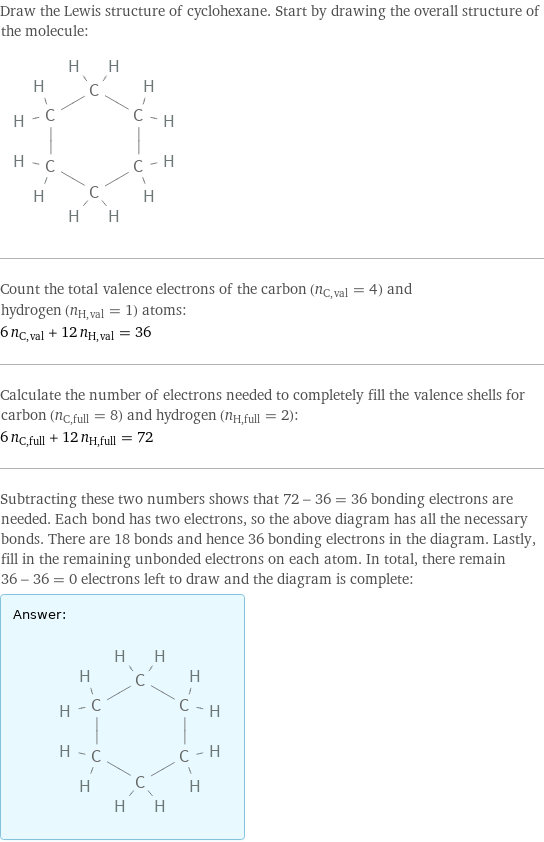
Draw the Lewis structure of cyclohexane. Start by drawing the overall structure of the molecule: Count the total valence electrons of the carbon (n_C, val = 4) and hydrogen (n_H, val = 1) atoms: 6 n_C, val + 12 n_H, val = 36 Calculate the number of electrons needed to completely fill the valence shells for carbon (n_C, full = 8) and hydrogen (n_H, full = 2): 6 n_C, full + 12 n_H, full = 72 Subtracting these two numbers shows that 72 - 36 = 36 bonding electrons are needed. Each bond has two electrons, so the above diagram has all the necessary bonds. There are 18 bonds and hence 36 bonding electrons in the diagram. Lastly, fill in the remaining unbonded electrons on each atom. In total, there remain 36 - 36 = 0 electrons left to draw and the diagram is complete: Answer: | |
3D structure

3D structure
Basic properties
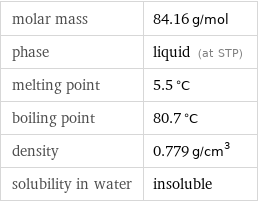
molar mass | 84.16 g/mol phase | liquid (at STP) melting point | 5.5 °C boiling point | 80.7 °C density | 0.779 g/cm^3 solubility in water | insoluble
Units

Liquid properties (at STP)
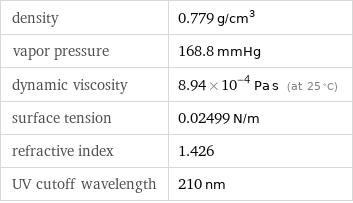
density | 0.779 g/cm^3 vapor pressure | 168.8 mmHg dynamic viscosity | 8.94×10^-4 Pa s (at 25 °C) surface tension | 0.02499 N/m refractive index | 1.426 UV cutoff wavelength | 210 nm
Units
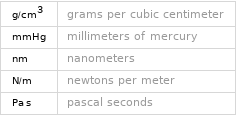
Thermodynamic properties
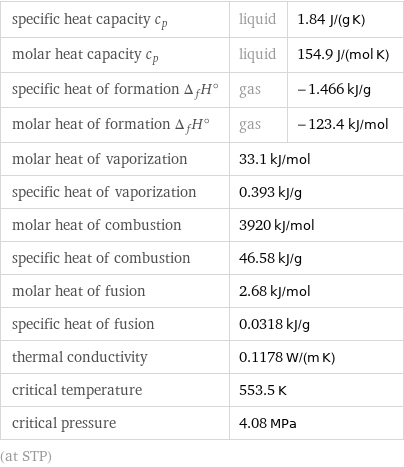
specific heat capacity c_p | liquid | 1.84 J/(g K) molar heat capacity c_p | liquid | 154.9 J/(mol K) specific heat of formation Δ_fH° | gas | -1.466 kJ/g molar heat of formation Δ_fH° | gas | -123.4 kJ/mol molar heat of vaporization | 33.1 kJ/mol | specific heat of vaporization | 0.393 kJ/g | molar heat of combustion | 3920 kJ/mol | specific heat of combustion | 46.58 kJ/g | molar heat of fusion | 2.68 kJ/mol | specific heat of fusion | 0.0318 kJ/g | thermal conductivity | 0.1178 W/(m K) | critical temperature | 553.5 K | critical pressure | 4.08 MPa | (at STP)
Basic drug properties

approval status | experimental | small molecule
Hydrophobicity and permeability properties

predicted LogP hydrophobicity | 3.46 experimental LogS | -3.1 predicted LogS | -3.33
Chemical identifiers
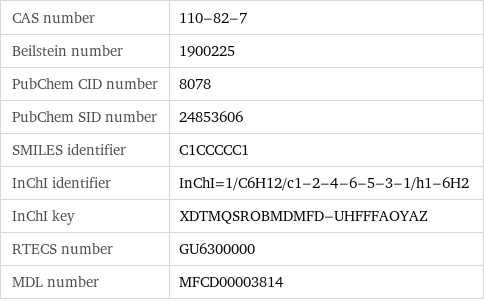
CAS number | 110-82-7 Beilstein number | 1900225 PubChem CID number | 8078 PubChem SID number | 24853606 SMILES identifier | C1CCCCC1 InChI identifier | InChI=1/C6H12/c1-2-4-6-5-3-1/h1-6H2 InChI key | XDTMQSROBMDMFD-UHFFFAOYAZ RTECS number | GU6300000 MDL number | MFCD00003814
NFPA label

NFPA label
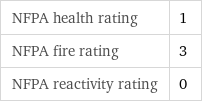
NFPA health rating | 1 NFPA fire rating | 3 NFPA reactivity rating | 0
Safety properties
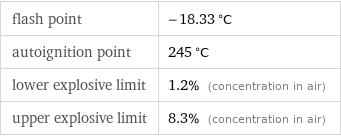
flash point | -18.33 °C autoignition point | 245 °C lower explosive limit | 1.2% (concentration in air) upper explosive limit | 8.3% (concentration in air)

DOT hazard class | 3 DOT numbers | 1145
Toxicity properties

lethal dosage | 12705 mg/kg (oral dose for rats) short-term exposure limit | 1300 mg/m^3 threshold limit value | 100 ppmv

probable lethal dose for man | 1 L (liter) long-term exposure limit | 1050 mg/m^3 (over 8 hours) RTECS classes | mutagen | primary irritant